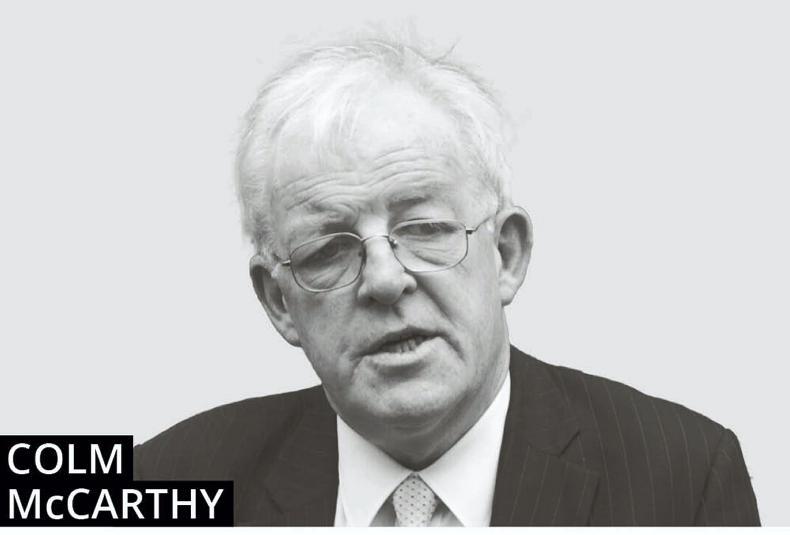It makes perfect sense to export goods and services from a country which enjoys, through its endowment of productive resources, a clear cost advantage.
Cheese from Munster is a better bet than grapes from Donegal and it makes sense to promote beach holidays in Spain but not in Siberia. There are choices to make about building capacity to export energy, especially electricity, which is among the most expensive in the European Union.
Ireland has embarked on a policy of encouraging more data centres in the belief, endorsed by the IDA, that this supports the tech industry here.
The tech sector has, along with pharma, been a stellar performer for several decades. But Eirgrid, the State company which is ultimately responsible for keeping the lights on, has called a halt to data centre development in the east region.
For the time being, electricity is in tight supply and the grid is short of capacity, especially around Dublin.
Recent reports from the European Commission’s Joint Research Centre (JRC) show that Ireland devotes a far larger portion of its electricity supplies to data centres than any other EU member state does, even though the domestic demand for the output of data centres, essentially storage and processing of digitised information for end-users, should be no greater.
End-users means every resident with a smartphone, as well as business firms, and Ireland’s demand for the output of data centres ought to be no greater than elsewhere in the better-off EU countries.
Since data centres consume so much electricity, not to mention water, also in tight supply in the east of Ireland, it is fair to ask whether Ireland is unconsciously doing a turn for the rest of the EU through hosting an awkward industry to facilitate others.
Structure
The key issues are about the structure of the data centre industry: is it producing mainly for export, and does it add enough value to offset the costs of further expansion?
Being receptive to data centre location of course helps in retaining Ireland’s attractions for the tech industry, which is naturally a concern at the IDA.
Ireland now has over 80 data centres with a backlog of applications for many more, and the portion of national electricity output they consume is already over 20%.
A decade ago, the figure was under 5% and data centre power consumption is the major source of demand growth.
Moreover, the favoured location is the region around Dublin, where grid constraints are most pressing.
Data from the JRC shows that Ireland, at 18% in 2022, was an outlier in Europe: in Germany data centres consumed around 5% of 2022 national electricity output, in the Netherlands about 3% and both countries had higher figures than the EU average where many were in the 1% to 2% range.
It may well be that Ireland has created an export business in electricity
The growth in telecommunications usage has been substantial in all countries. Some of the demand for data centres comes from domestic sources but the JRC report indicates that Ireland is not an outlier in this regard.
The implication is that most of the capacity in Ireland is for export. If the principal component in data centre activity is the input of electricity, since the direct employment level is low, it may well be that Ireland has created an export business in electricity.
One of the lobby groups for the tech companies, Host in Ireland, wants more expansion and complains that “we have gone from leader to flounderer”, according to the Financial Times.
Minister for Public Expenditure Paschal Donohoe seems to agree. He has spoken about the opportunity to spend more on infrastructure and the export of clean energy.
He told The Currency: “I believe that is an economic opportunity for Ireland that is at least equal to any of the other economic opportunities that my predecessors identified”.
If it is indeed the case that Ireland enjoys abundant sources of clean energy, sufficient to support an electricity export expansion, well and good.
The energy regulator, the CRU, is preparing a review to be published soon on balancing the conflicts between energy sector expansion and the decarbonisation agenda.
It would be helpful to see a full costing, in terms of the end-user cost of electricity, of the plans for deep-water Atlantic wind, for example, widely assumed to be an easy way to square the circle.
No comprehensive costing, sufficient to justify the minister’s optimism, has been made available.
Overall targets
There are overall national targets for carbon emissions and possible EU financial penalties. Failure in any major sector like electricity will result in spillover into tighter targets for all the others.
One of these is farming.
There is a strategic choice between exporting goods and services in which there is an established competitive advantage and risking their curtailment by promoting high-emission export industries before the costs and benefits have been assessed.






 This is a subscriber-only article
This is a subscriber-only article










SHARING OPTIONS: